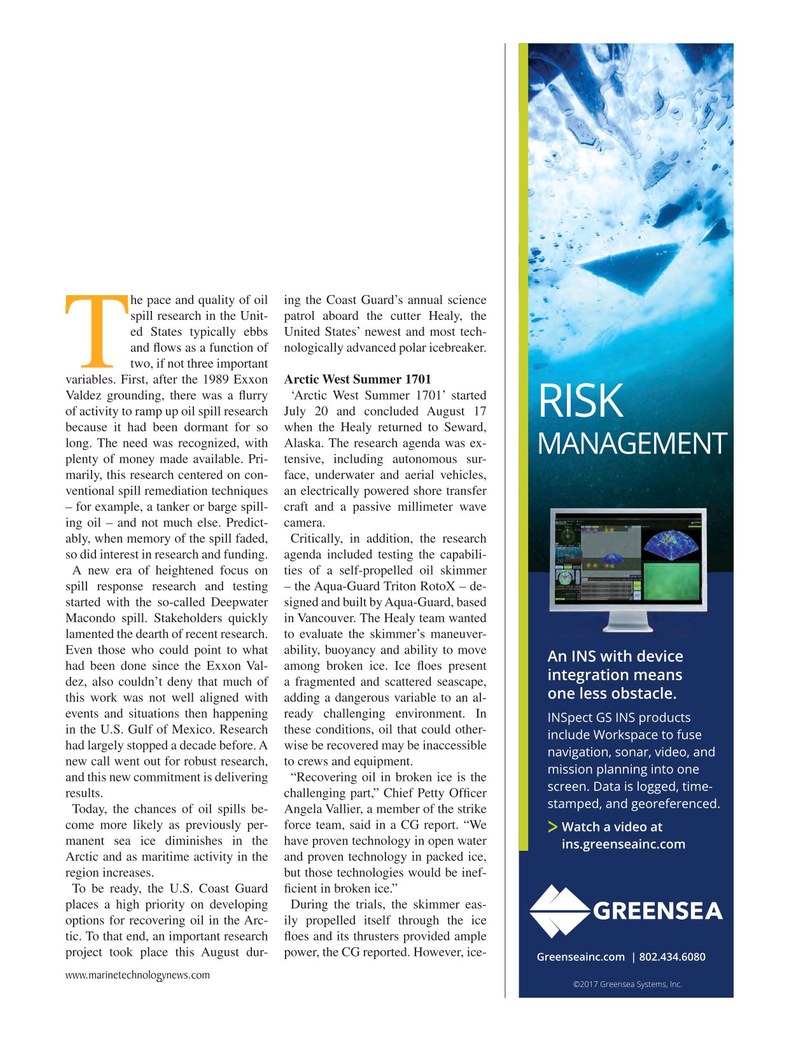
Page 41: of Marine Technology Magazine (October 2017)
AUV Operations
Read this page in Pdf, Flash or Html5 edition of October 2017 Marine Technology Magazine
he pace and quality of oil ing the Coast Guard’s annual science spill research in the Unit- patrol aboard the cutter Healy, the ed States typically ebbs United States’ newest and most tech- and ? ows as a function of nologically advanced polar icebreaker.
Ttwo, if not three important variables. First, after the 1989 Exxon Arctic West Summer 1701
Valdez grounding, there was a ? urry ‘Arctic West Summer 1701’ started of activity to ramp up oil spill research July 20 and concluded August 17
RISK because it had been dormant for so when the Healy returned to Seward, long. The need was recognized, with Alaska. The research agenda was ex-
MANAGEMENT plenty of money made available. Pri- tensive, including autonomous sur- marily, this research centered on con- face, underwater and aerial vehicles, ventional spill remediation techniques an electrically powered shore transfer – for example, a tanker or barge spill- craft and a passive millimeter wave ing oil – and not much else. Predict- camera.
ably, when memory of the spill faded, Critically, in addition, the research so did interest in research and funding. agenda included testing the capabili-
A new era of heightened focus on ties of a self-propelled oil skimmer spill response research and testing – the Aqua-Guard Triton RotoX – de- started with the so-called Deepwater signed and built by Aqua-Guard, based
Macondo spill. Stakeholders quickly in Vancouver. The Healy team wanted lamented the dearth of recent research. to evaluate the skimmer’s maneuver-
Even those who could point to what ability, buoyancy and ability to move
An INS with device had been done since the Exxon Val- among broken ice. Ice ? oes present integration means dez, also couldn’t deny that much of a fragmented and scattered seascape, one less obstacle.
this work was not well aligned with adding a dangerous variable to an al- events and situations then happening ready challenging environment. In
INSpect GS INS products in the U.S. Gulf of Mexico. Research these conditions, oil that could other- include Workspace to fuse had largely stopped a decade before. A wise be recovered may be inaccessible navigation, sonar, video, and new call went out for robust research, to crews and equipment.
mission planning into one and this new commitment is delivering “Recovering oil in broken ice is the screen. Data is logged, time- results. challenging part,” Chief Petty Of? cer stamped, and georeferenced.
Today, the chances of oil spills be- Angela Vallier, a member of the strike come more likely as previously per- force team, said in a CG report. “We
Watch a video at > manent sea ice diminishes in the have proven technology in open water ins.greenseainc.com
Arctic and as maritime activity in the and proven technology in packed ice, region increases. but those technologies would be inef-
To be ready, the U.S. Coast Guard ? cient in broken ice.” places a high priority on developing During the trials, the skimmer eas- options for recovering oil in the Arc- ily propelled itself through the ice tic. To that end, an important research ? oes and its thrusters provided ample project took place this August dur- power, the CG reported. However, ice-
Greenseainc.com | 802.434.6080 www.marinetechnologynews.com ©2017 Greensea Systems, Inc.
MTR #8 (34-49).indd 41 MTR #8 (34-49).indd 41 9/28/2017 5:00:27 PM9/28/2017 5:00:27 PM

 40
40

 42
42
